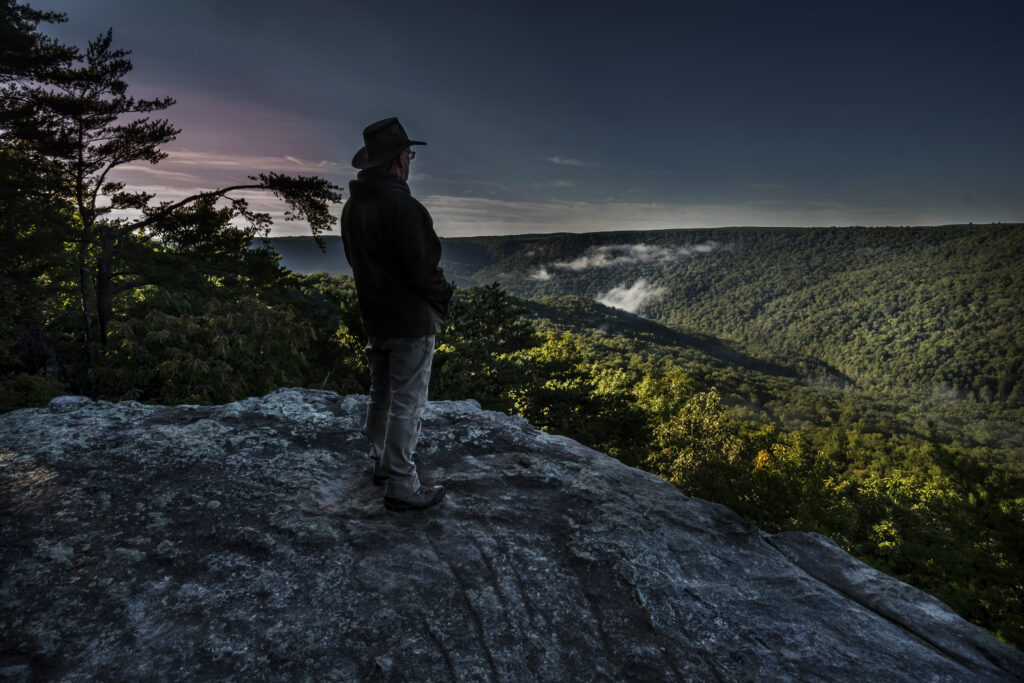Mike O’Neal, a longtime hunter, surveys an expanse of the Bridgestone Firestone Centennial Wilderness Area. (Photo: John Partipilo)
If you’ve spent time in one of the South’s designated wilderness areas, you likely know the feeling of being truly alone with nature. While the terrains may differ — some are home to coastal swamps, others preserve towering trees or sweeping mountain landscapes — the experiences are remarkably similar: the areas provide unmatched solitude and some of the most unique ways to get into the outdoors. These incredible places are made possible thanks to the Wilderness Act, which turned 60 years old earlier this month.
The Wilderness Act was signed into law on September 3, 1964. With the stroke of his pen, President Lyndon Johnson offered permanent protections for areas where, in the law’s words, “the Earth and its community of life are untrammeled by man, where man himself is a visitor who does not remain.”
Of course, today we know areas that are “untrammeled by man” are a myth: Indigenous peoples had been using lands across the countries for millennia before Europeans arrived. But wilderness designation was nevertheless an essential bulwark against the unrestrained appetites of the colonizers. The law’s signing remains one of the most important moments in the fight to protect some of the nation’s most important public lands.
The Wilderness Act had an immediate impact in the South. North Carolina’s Shining Rock and Linville Gorge Wilderness Areas were established by the legislation, becoming two of the country’s original wilderness areas. Tennessee wasn’t far behind; the Gee Creek, Cohutta, and Joyce Kilmer-Slickrock Wilderness Areas became the first in Volunteer State just nine years later.
President Lyndon Johnson signed the Wilderness Act into law on Sept. 3, 1964, and September annually is Wilderness Month. (Photo by Keystone/Getty Images)
These and other wilderness areas continue to be popular in the South. Studies show that nine out of ten Southerners support the preservation of Wilderness Areas and think more public lands should be protected. Even those who have yet to visit a wilderness area can appreciate their ability to filter water for nearby communities and create habitat for rare and endangered animals
But in the decades since the law was signed, the South has lagged behind when it comes to creating wilderness. Today, fewer than three percent of the nation’s wilderness acres are in the South.
This is especially concerning because the South can benefit the most from additional public lands protections. It is the fastest-growing region in the country, and that rapid growth puts incredible pressure on our public lands. The South also has a long history of extractive industries degrading public lands. Even today, some of the region’s best wilderness candidates are threatened by development. Just up I-81 in Virginia, the Mountain Valley Pipeline recently clear cut its way across the Brushy Mountain Roadless Area, scarring this previously intact area forever.
Now, grassroots groups across the South are hoping to fend off these threats for good by fighting to protect more of the region’s public lands. In Virginia, advocates are pushing to create the Shenandoah Mountain National Scenic Area and working to expand wilderness areas in the George Washington and Jefferson National Forests. In Arkansas, a proposal to expand the Flatside Wilderness is gaining steam. In North Carolina, there’s a strong push to get Craggy Mountain – one of the state’s most iconic places – designated as a National Scenic Area with wilderness components included.
Wilderness areas can only be created by an act of Congress, and while these kinds of proposals spark intense conflict in the American West, they often receive bipartisan support in the South. For evidence, you don’t need to look any farther than the mountains of East Tennessee, where the most recent southern wilderness bill, the Tennessee Wilderness Act, established nearly 20,000 acres of wilderness in the Cherokee National Forest in 2018. The bill was introduced by then-Sen. Lamar Alexander and supported by fellow Republicans as well as Democrats. In an era of extreme partisanship, wilderness areas can at times seem like one of the few things Southern politicians can agree on.
So, as the Wilderness Act enters its seventh decade of existence, don’t just celebrate by enjoying a wilderness area, but get involved in efforts to preserve some of the South’s most important landscapes.
GET THE MORNING HEADLINES DELIVERED TO YOUR INBOX

